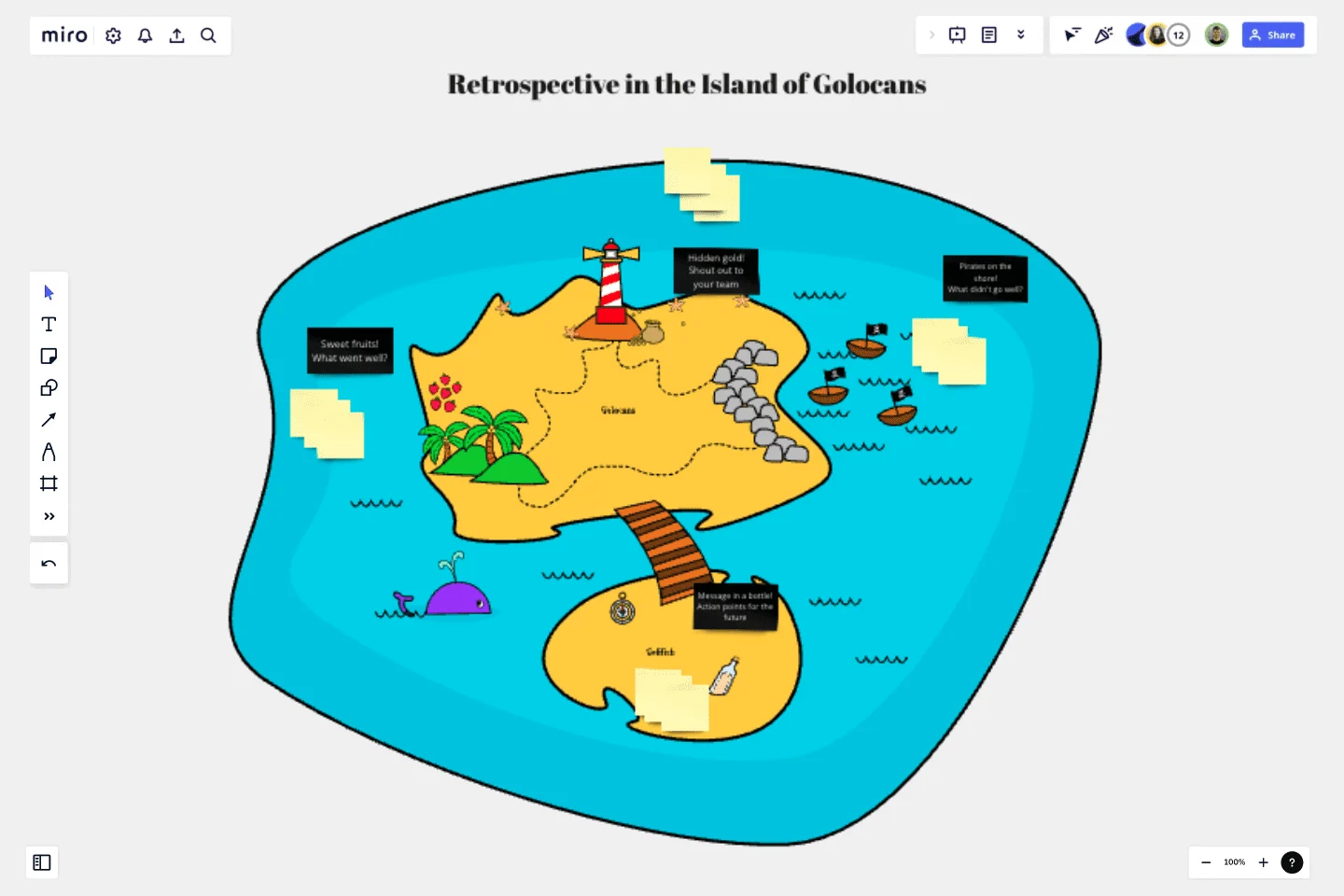Retrospective in the Island of Golocans
The Island of Golocans has four very unique characteristics. Run a effective retrospective with it.
The Island of Golocans has four very unique characteristics. The West has an abundance of sweet fruits, green hills and plenty of trees for some shade during peak summer. Apparently, the North of this island has some hidden gold coins near a lighthouse. In this region, one might spot plenty of starfish, too. The East coast is notorious for invading pirates - not all of them make it through the rough seas, though. The few that make it have to then climb up very uncomfortable rocks and only then will they be able to enter this island. Finally, the South Island, which is also known as Golifish, is connected with a wooden bridge. This region is very popular with voyagers who often come here and leave notes in glass bottles for future readers. They often also leave items of significance, like a compass, for guiding their journey to this island.
When performing a retrospective on the Island of Golocans, remember to cover all four directions:
Sweet fruits! What went well during the last sprint? Add a post-it note with your thoughts and celebrate your wins.
Hidden gold! Give your team a shout-out for the amazing work they've been putting in, the nuggets of information they provide, and for just being an awesome person to work with.
Pirates on the shore! This doesn't sound good, does it? Recall what didn't go well in the last sprint and write them down on each post-it note.
Message in a bottle! Record action points for the future. If you've thought of actionable items you and your teammates could work on to ensure that things can be better in the next sprint, make a note of them. If you have general ideas that can be implemented in the next sprint, make a note of them, too!
Have a pleasant time exploring this island!
This template was created by Clyde D'Souza
Explore all Miro's tool for online retrospectives and run more engaging and inclusive retros.
Get started with this template right now.
FMEA Analysis Template
Works best for:
Agile Methodology, Strategic Planning, Software Development
When you’re building a business or running a team, risk comes with the territory. You can’t eliminate it. But you CAN identify it and mitigate it, to up your odds of success. Failure Modes and Effects Analysis (FMEA) is a powerful tool designed to help you manage risk and potential problems by spotting them within a process, product, or system. And you’ll spot them earlier in your process—to let you sidestep costly changes that arise late in the game or, worse, after they’ve impacted your customers and their experience.
Entity Relationship Diagram Template
Works best for:
Flowcharts, Strategic Planning, Diagrams
Sometimes the most important relationships in business are the internal ones—between the teams, entities, and actors within a system. An entity relationship diagram (ERD) is a structural diagram that will help you visualize and understand the many complex connections between different roles. When will an ERD come in handy? It’s a great tool to have for educating and onboarding new employees or members of a team, and our template makes it so easy to customize according to your unique needs.
Reflection Island: End of Year Team Retro
Works best for:
Retrospectives, Agile Methodology, Meetings
The Reflection Island: End of Year Team Retro template offers a creative and themed approach to retrospectives, perfect for wrapping up the year. It provides elements for reflecting on achievements, challenges, and goals using a tropical island theme. This template enables teams to celebrate successes, learn from setbacks, and set intentions for the upcoming year in a relaxed and enjoyable atmosphere. By promoting reflection and celebration, the Reflection Island: End of Year Team Retro empowers teams to strengthen bonds, boost morale, and start the new year with renewed energy and focus effectively.
A Halloween Retro
Works best for:
Retrospectives, Meetings, Agile Methodology
The Retrospective Halloween template offers a themed approach to retrospectives, perfect for the spooky season. It provides elements for reflecting on past iterations, identifying scary issues, and brainstorming solutions. This template enables teams to have fun while addressing serious topics, fostering creativity and collaboration. By promoting a playful yet productive atmosphere, the Retrospective Halloween empowers teams to tackle challenges, drive improvement, and strengthen team cohesion effectively.
Lean Change Self-Starter Kit
Works best for:
Agile
The Lean Change Self-Starter Kit is a comprehensive resource for initiating organizational change using Lean principles. It provides tools and templates for assessing readiness, defining change objectives, and planning interventions. This template empowers change agents to navigate complexity, engage stakeholders, and drive meaningful transformation. By promoting adaptability and experimentation, the Lean Change Self-Starter Kit enables organizations to embrace change as a competitive advantage and achieve sustainable growth.
Agile Retrospective
Works best for:
Retrosprective, Agile Methodology, Meetings
The Agile Retrospective template offers a dynamic and adaptive framework for teams practicing agile methodologies. It provides elements for reflecting on sprint performance, identifying bottlenecks, and planning improvements. This template enables teams to adapt and refine their processes continuously, fostering a culture of learning and innovation. By promoting agility and adaptability, the Agile Retrospective empowers teams to optimize their workflows, drive continuous improvement, and deliver value to their stakeholders effectively.
